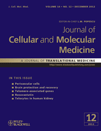Analysis of CYP2C9*2,CYP2C9*3 and VKORC1 -1639 G>A polymorphisms in a population from South-Eastern Europe
Abstract
The CYP2C9 enzyme metabolizes a wide range of relevant drugs, among which are oral anticoagulants. VKORC1 is the pharmacodynamic target of the oral anticoagulants. The genetic polymorphisms CYP2C9*2, CYP2C9*3 and VKORC1 -1639 G>A are the major determinants of the inter-individual variability in the dosage requirements of oral anticoagulants. This study provides a first evaluation of these 3 polymorphisms in a Romanian population. A total of 332 Romanian individuals were genotyped for the CYP2C9*2, CYP2C9*3 and VKORC1 -1639 G>A polymorphisms using the PCR-RFLP technique. Sixty-two individuals (18.7%) were heterozygous for CYP2C9*2, whereas 47 individuals (14.1%) were heterozygous for CYP2C9*3. Fourteen individuals (4.2%) had a CYP2C9*2 homozygous, CYP2C9*3 homozygous or CYP2C9*2/CYP2C9*3 compound heterozygous genotype. These individuals are predicted to have the lowest CYP2C9 enzymatic activity. The allele frequencies of the CYP2C9*2 and CYP2C9*3 polymorphisms were 11.3% and 9.3% respectively. For the VKORC1 -1639 G>A polymorphism, there were 170 heterozygotes (51.2%) and 55 (16.6%) homozygotes for the A allele. The frequency of the A allele was 42.2%. Overall, the distribution of the CYP2C9*2, CYP2C9*3 and VKORC1 -1639 G>A polymorphisms observed in our cohort is in accordance with other Caucasian populations. A large number of Romanians are expected to harbour at least one CYP2C9 variant allele and/or one VKORC1 -1639 G>A allele. This frequency has major implications in the pharmacogenomics of oral anticoagulants in Romanians.




